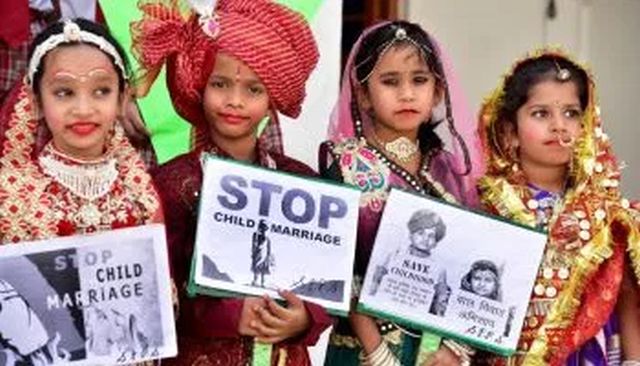
by Editor | May 25, 2021 | News
 New Delhi : There has been a significant drop in the number of child marriages in India — from nearly 50 to 30 per cent — in the last 10 years, a survey by UN children’s agency Unicef showed on Tuesday.
New Delhi : There has been a significant drop in the number of child marriages in India — from nearly 50 to 30 per cent — in the last 10 years, a survey by UN children’s agency Unicef showed on Tuesday.
There has been significant drop globally in the practice as well, and 25 million child marriages have been prevented in the past decade worldwide, the UN Children’s Fund said.
According to the new data, the total number of girls across the globe married in childhood is now estimated at 12 million a year.
Unicef pointed that worldwide, an estimated 650 million women alive today were married off as children.
South Asia witnessed the largest decline in child marriages worldwide in the last decade as a girl’s risk of marrying before turning 18 dropped by more than a third.
One in five girls are now married before they are 18, compared with one in four a decade ago.
According to the Unicef, increasing rates of girls’ education, proactive government investments in adolescent girls, and strong public messaging around the illegality of child marriage and the harm it causes are among the reasons for the shift.
However, Unicef also noted that despite the overall decline in India, national and state averages mask realities at the district level as a few districts continue to have high rates of child marriage.
“The states with the highest prevalence of child marriage are Bihar, West Bengal and Rajasthan with close to 40 per cent prevalence.
“While Tamil Nadu and Kerala have prevalence below 20 per cent, they have pockets of disparity concentrated in tribal communities and amongst particular castes including the Schedule Castes,” the agency added.
“When a girl is forced to marry as a child she faces immediate and lifelong consequences. Her odds of finishing school decrease while her odds of being abused by her husband and suffering complications during pregnancy increase.
“There are also huge societal consequences, and higher risk of intergenerational cycles of poverty,” Anju Malhotra, Unicef’s principal gender adviser, said.
The report said that the burden of child marriage was shifting to sub-Saharan Africa, where more progress was needed to offset population growth. Nearly one in three child marriages were now in sub-Saharan Africa, compared with one in five a decade ago.
World leaders have vowed to end child marriage by 2030 under the UN Sustainable Development Goals.
Malhotra said that to meet that target, efforts had to be stepped up “to prevent millions of girls having their childhoods stolen through this devastating practice”.
—IANS

by Editor | May 25, 2021 | Economy, Marketing Basics, Markets, Media, News, Online Marketing, Social Media, Technology
 Kolkata : With less than one-third of India’s internet users being females, the country’s girls and women risk becoming further marginalised in society and at home if they remain digitally illiterate in the backdrop of the country making a public push towards a more digitalised economy, a Unicef report says.
Kolkata : With less than one-third of India’s internet users being females, the country’s girls and women risk becoming further marginalised in society and at home if they remain digitally illiterate in the backdrop of the country making a public push towards a more digitalised economy, a Unicef report says.
“There is a digital gender gap as well. Globally, 12 per cent more men than women used the internet in 2017. In India, less than one third of internet users are female.
“… Recently, India has made a public push towards a more digitali sed economy, including reducing dependency on physical cash. If girls and women remain digitally illiterate, they risk becoming further marginalised in society and at home,” says the 2017 edition of Unicef’s annual flagship publication “the State of the World’s Children Report” launched here on Thursday.
Themed “Children in a digital world”, the latest report provides country-level examples to give a sense of the kinds of barriers girls and women confront.
In India, where only 29 per cent of all internet users are female, girls in rural areas often face restrictions on their use of ICTs solely because of their gender, it says.
Citing examples, the report quotes a village governing body in rural Rajasthan as stating that “girls were not to use mobile phones or social media”.
“Another village in Uttar Pradesh banned unmarried girls from using mobile phones along with a ban on wearing certain kinds of clothing, such as jeans and T-shirts.”
Pointing out that digital connection and literacy offer advantages in a knowledge-based society, improving children’s lives and their fut ure earning potential, the report says: “At the same time, connectivity doesn’t always equalise opportunity.”
“Digital divides can mirror broader societal divides — between rich and poor, cities and rural areas, between those with or without an education — and between women and men.
“India is one place in which the digital divide highlights society’s deep chasms,” says the report, calling for addressing the disparity at the highest levels for universal, safe access to be realised.
It says the digital gender divide is caused by a number of factors — “social norms, education levels, lack of technical literacy and lack of confidence among them — but is often rooted in parents’ concern for the safety of their daughters.
“Many fear that allowing girls to use the internet will lead to liaisons with men, bringing shame on the family. For most girls, if they are allowed to use the internet, their every move is monitored by their parents or brothers.
“In a society that is still largely patriarchal, for girls, traits like deference and obedience are often valued over intelligence and curiosity. In some households, technology is not seen as necessary or beneficial for girls and women,” the report says.
—IANS

 New Delhi : There has been a significant drop in the number of child marriages in India — from nearly 50 to 30 per cent — in the last 10 years, a survey by UN children’s agency Unicef showed on Tuesday.
New Delhi : There has been a significant drop in the number of child marriages in India — from nearly 50 to 30 per cent — in the last 10 years, a survey by UN children’s agency Unicef showed on Tuesday.
